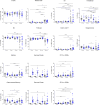This is a preprint.
Effect of Age on Xenobiotic-Induced Autoimmunity
- PMID: 40502004
- PMCID: PMC12154840
- DOI: 10.1101/2025.05.22.655368
Effect of Age on Xenobiotic-Induced Autoimmunity
Abstract
Aging is associated with increased spontaneous autoantibody production and chronic inflammation, yet its impact on xenobiotic-induced autoimmunity remains unexplored. This study investigates the effect of age on mercury-induced autoimmunity (HgIA) in B10.S mice, a model of xenobiotic-induced autoimmunity characterized by anti-nucleolar autoantibodies (ANoA). Mature (3 months), adult (6 months), middle-aged (12 months), and old-age (24 months) mice were exposed to mercury (HgCl2) or phosphate-buffered saline (PBS) for 4-5 weeks. While spontaneous anti-nuclear antibodies (ANA) increased with age in PBS-treated mice (34% in middle-aged, 57% in old age mice), HgIA incidence declined in old age mice, with only 59% (26/44) developing significant ANoA titers compared to 91-100% in younger cohorts. Notably, 56% (10/18) of initially ANoA-negative old mice had detectable ANoA at a lower dilution, indicating a reduced but not absent response. ANoA negativity in old age mice was associated with lower immunoglobulin levels, reduced anti-chromatin antibodies, and diminished germinal center formation, suggestive of immunosenescence. Flow cytometry revealed age-related declines in CD4⁺ T cells, with mercury exposure augmenting T-cell differentiation in younger but not old mice. These findings demonstrate that aging enhances spontaneous autoimmunity but impairs xenobiotic-induced autoimmunity, with a subset of old age mice retaining partial responsiveness at lower dilutions, highlighting the complex interplay between immunosenescence and environmental triggers.
Figures












Similar articles
-
Surveillance for Violent Deaths - National Violent Death Reporting System, 50 States, the District of Columbia, and Puerto Rico, 2022.MMWR Surveill Summ. 2025 Jun 12;74(5):1-42. doi: 10.15585/mmwr.ss7405a1. MMWR Surveill Summ. 2025. PMID: 40493548 Free PMC article.
-
Frequent oil baths and skin barrier during infancy in the PreventADALL study.Br J Dermatol. 2024 Jun 20;191(1):49-57. doi: 10.1093/bjd/ljae091. Br J Dermatol. 2024. PMID: 38446755 Clinical Trial.
-
Use of β-adrenoreceptor drugs and Parkinson's disease incidence in women from the French E3N cohort study.J Parkinsons Dis. 2025 Jun;15(4):789-804. doi: 10.1177/1877718X251330993. Epub 2025 Apr 29. J Parkinsons Dis. 2025. PMID: 40302366
-
Prevalence and odds of anxiety and depression in cutaneous malignant melanoma: a proportional meta-analysis and regression.Br J Dermatol. 2024 Jun 20;191(1):24-35. doi: 10.1093/bjd/ljae011. Br J Dermatol. 2024. PMID: 38197404
-
Global Delphi consensus on treatment goals for generalized pustular psoriasis.Br J Dermatol. 2025 Mar 18;192(4):706-716. doi: 10.1093/bjd/ljae491. Br J Dermatol. 2025. PMID: 39844356
References
Publication types
Grants and funding
LinkOut - more resources
Full Text Sources
Research Materials
